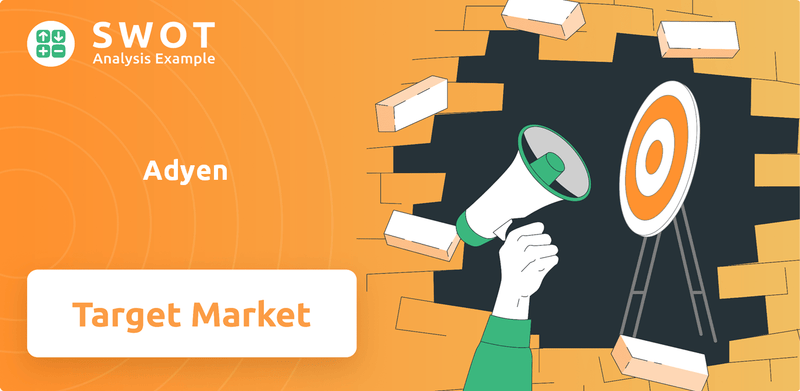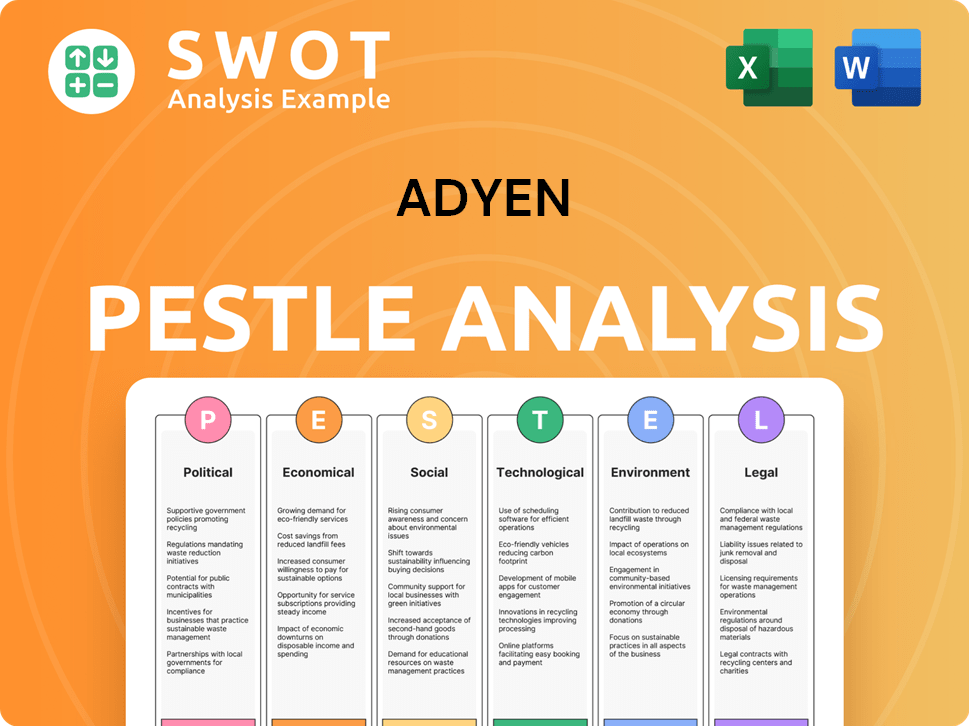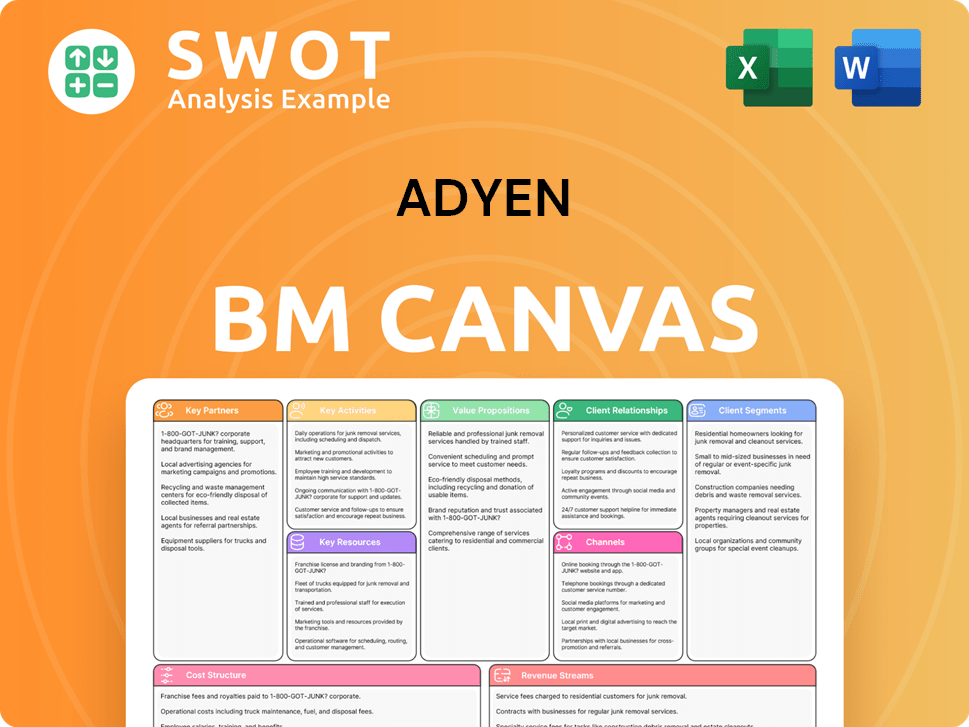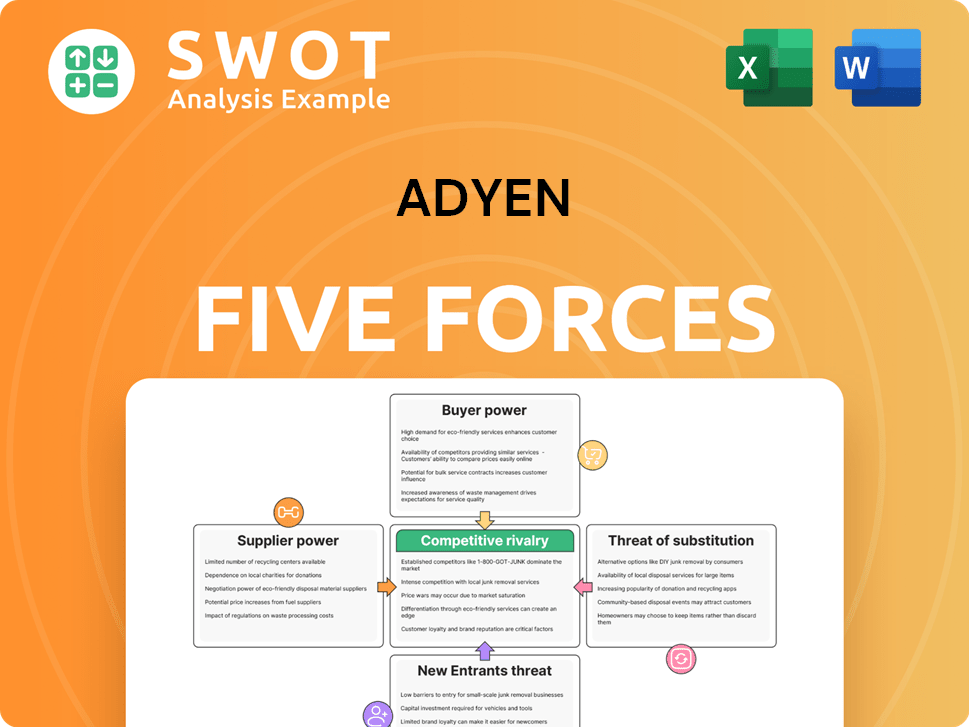Adyen Bundle
Who Does Adyen Serve in the Fintech Revolution?
In the ever-changing world of digital commerce, understanding customer demographics is crucial for companies like Adyen. This isn't just about staying ahead; it's about survival in a market shaped by shifting consumer behaviors and technological advancements. Adyen, a leader in the payment processing industry, has built its success on a deep understanding of its target market and a commitment to meeting their evolving needs.

Adyen's remarkable growth, processing €1.29 trillion in 2024, highlights the importance of a laser focus on its Adyen SWOT Analysis. This analysis reveals the company's customer profile, including the specific needs and preferences of its merchants. By examining Adyen's customer base size, target audience for online payments, and customer segmentation strategy, we can gain a deeper understanding of its strategic approach to the payment processing industry and its continued success in the global market.
Who Are Adyen’s Main Customers?
Understanding the customer demographics Adyen targets is crucial for grasping its market position and strategic direction. The company primarily focuses on businesses, operating in a B2B model, and offers a comprehensive financial technology platform. This platform caters to a diverse range of customer groups, from large global enterprises to SMBs.
Adyen's strategy emphasizes expanding its 'share of wallet' with existing enterprise customers, indicating a focus on deepening relationships with major clients. In 2024, the company continued to onboard new enterprise customers across various sectors, including insurance and healthcare, as these industries undergo digital transformation. This expansion highlights Adyen's adaptability and its ability to meet the evolving needs of different business sectors.
The Adyen customer profile includes a mix of merchants with varying operational models. These models range from unified commerce merchants to digital-focused businesses and platform businesses. This diversity allows Adyen to serve a broad spectrum of clients within the payment processing industry, solidifying its position in the market.
These businesses seek seamless integration of online (e-commerce) and in-store (Point of Sale or POS) payments. In H2 2024, unified commerce volume reached €194.2 billion, representing a 35% year-over-year increase, with 55% online and 45% in-store transactions. This segment highlights the growing demand for integrated payment solutions.
This segment primarily relies on online payment processing. While still the largest share of processed volumes at 58% in H2 2024, its share has decreased from 62% in H2 2023 as other segments grow. This shift indicates the evolving landscape of the payment processing industry.
This is Adyen's fastest-growing segment, with platform volume growing 51% year-over-year in 2024 (70% excluding the eBay wind-down). At the end of 2024, 'Adyen for Platforms' served 28 platforms with over €1 billion in annual payment volume, up from 18 platforms in 2023. This segment indirectly serves approximately 145,000 SMBs, an increase from 88,000 SMBs at the end of 2023.
This segment indirectly serves approximately 145,000 SMBs, an increase from 88,000 SMBs at the end of 2023. This expansion highlights Adyen's strategic shift towards enabling other businesses to offer financial services, effectively expanding its reach into the SMB market without directly serving them.
Adyen's Adyen target market has evolved, moving from a primary focus on online payment processing to a more comprehensive 'full-stack' approach. This shift is driven by the increasing demand for unified commerce solutions and the trend of businesses seeking a single platform for all their payment needs. The company's emphasis on enterprise clients and high-volume platforms highlights its strategy to capture significant market share through large-scale partnerships. For a deeper understanding of Adyen's strategic approach, consider exploring the Marketing Strategy of Adyen.
Adyen's customer base is diverse, encompassing unified commerce merchants, digital-focused businesses, and platform businesses. The company's focus on enterprise clients and high-volume platforms underscores its strategy to capture significant market share through large-scale partnerships.
- Unified commerce volume reached €194.2 billion in H2 2024.
- Platform volume grew 51% year-over-year in 2024.
- 'Adyen for Platforms' served 28 platforms with over €1 billion in annual payment volume by the end of 2024.
- Adyen's customer acquisition strategy includes attracting both large enterprises and SMBs through its platform solutions.
Adyen SWOT Analysis
- Complete SWOT Breakdown
- Fully Customizable
- Editable in Excel & Word
- Professional Formatting
- Investor-Ready Format

What Do Adyen’s Customers Want?
Understanding the needs and preferences of businesses is crucial for any payment processing company. For Adyen, a deep understanding of its customers, primarily other businesses (B2B), is fundamental to its success. This focus allows for tailored solutions that meet the complex demands of the payment processing industry.
Adyen's customer profile is shaped by a desire for efficiency, global reach, security, and data-driven insights. These businesses are looking for a payment platform that simplifies their operations and enables them to grow, both domestically and internationally. The company addresses these needs with a unified commerce approach.
The core motivation for choosing Adyen stems from a desire for a single, integrated platform that streamlines payment flows across various channels and geographies. This 'Unified Commerce' approach, which seamlessly integrates online and in-store payments, is highly valued by Adyen's merchants.
Businesses seek to reduce the complexity of managing multiple payment providers. Adyen's unified solution combines gateway, acquiring, risk management, and analytics into a single platform.
Given that nearly half of global businesses experienced fraud in 2024, customers value advanced risk management tools. Adyen's AI-powered fraud detection capabilities, such as RevenueProtect and Adyen Uplift, are highly valued.
Merchants desire a cohesive view of their payments data to gain intelligent insights into trends and behaviors. This enables personalized offers and better business decisions.
The ability to tailor payment experiences, manage cash flow, and offer flexible payment terms are increasingly important. Adyen's partnerships, such as with Billie, highlight this trend.
Businesses, especially large enterprises, need a platform that can scale with their growth. They also need support for efficient expansion into new international markets.
Adyen's customer base includes a diverse range of businesses, from startups to large enterprises, all seeking efficient and reliable payment solutions. These businesses are driven by the need to streamline operations, reduce fraud, and gain insights from their payment data. The company's focus on innovation and customer feedback ensures that it continues to meet the evolving needs of its target market. For more details on the business model, you can refer to the Revenue Streams & Business Model of Adyen.
Adyen's customers, or Adyen merchants, prioritize several key features and benefits. These preferences drive their decisions within the payment processing industry. Key drivers include streamlined operations, fraud prevention, data insights, and global reach.
- Streamlined Operations: Businesses prefer a unified solution to manage payments, reducing the complexity of multiple providers.
- Fraud Prevention and Risk Management: Advanced tools and AI-powered fraud detection are highly valued.
- Data-Driven Insights: Merchants want a cohesive view of their payment data for better decision-making.
- Flexibility and Customization: Tailoring payment experiences and offering flexible terms are increasingly important.
- Scalability and Global Reach: Businesses need a platform that can grow with them and support international expansion.
Adyen PESTLE Analysis
- Covers All 6 PESTLE Categories
- No Research Needed – Save Hours of Work
- Built by Experts, Trusted by Consultants
- Instant Download, Ready to Use
- 100% Editable, Fully Customizable

Where does Adyen operate?
The geographical market presence of Adyen is extensive, with direct operations and licenses in over 30 countries. This wide reach allows it to serve a globalized customer base effectively. The company's net sales are spread across various key regions, with Europe/Middle East/Africa (EMEA) being the largest market.
Adyen's strategic focus and investments are tailored to each region, ensuring it meets the specific needs of its merchants. This localized approach is a key element in its customer acquisition strategy. The company's expansion plans and hiring strategies highlight its commitment to strengthening its position in key markets such as North America, Japan, and India.
Understanding the customer demographics of Adyen and its target market is crucial for appreciating its global success. The company's ability to adapt to local payment preferences and build direct connections with domestic payment networks underscores its customer-centric approach. For more insights into the company's structure, you can read about the Owners & Shareholders of Adyen.
EMEA remains Adyen's strongest market, with revenue increasing by 27% to €625 million in H2 2024. For the full year, the revenue grew by 26% to €1.1 billion. This growth is supported by its established 'three-pillar offering' which includes Digital, Unified Commerce, and Platforms.
North America is a key growth market, with a 21% increase in H2 2024, reaching €292 million in revenue. In 2024, North America contributed approximately 27% of Adyen's net revenue. Adyen expanded its physical presence by opening larger offices in San Francisco and Chicago.
APAC experienced a 12% growth in H2 2024, with revenue reaching €110 million. Adyen has made significant strides in APAC, processing payments for KFC and broadening its partnership with Vietnam Airlines. This expansion includes acquiring services in markets like Japan and Australia.
Latin America (LatAm) showed a slight decline of -1% in H2 2024, but demonstrated a 12% year-over-year growth on a constant currency basis. Adyen integrated with Brazil's Pix to drive conversion and lower costs. This reflects the company's adaptability in the payment processing industry.
Adyen builds direct connections to domestic payment networks. This includes Faster Payments in the UK, FedNow in the US, and Pix in Brazil. These connections allow for greater customization and operational control in each market.
Businesses using Adyen can accept payment methods preferred by international shoppers. This includes options like Alipay and WeChat Pay. This capability is a key part of Adyen's business model.
Adyen secured an Online Payment Aggregator license in India in 2024. It also established a technology hub in Bengaluru. These moves position Adyen to accelerate payment innovation in India's rapidly growing e-commerce market.
The company plans to increase hiring in 2025. It will continue to focus on investments in North America, Japan, and India. These investments will support its customer acquisition strategy.
Adyen Business Model Canvas
- Complete 9-Block Business Model Canvas
- Effortlessly Communicate Your Business Strategy
- Investor-Ready BMC Format
- 100% Editable and Customizable
- Clear and Structured Layout

How Does Adyen Win & Keep Customers?
focuses on a multi-pronged strategy for acquiring and retaining customers. This strategy centers on technological innovation, unified commerce solutions, and strategic partnerships. The company aims to provide a 'subscription to innovation,' consistently improving its platform to meet the evolving needs of its merchants. Understanding the customer demographics of businesses using is key to tailoring these strategies effectively.
The company's approach to customer acquisition and retention is multifaceted, emphasizing its advanced technology, unified commerce capabilities, and strategic alliances. The core of its strategy involves continuous platform enhancement and product feature updates to align with the changing demands of its customers. This proactive approach is essential for maintaining a competitive edge in the payment processing industry.
The success of these strategies is reflected in its financial performance. In 2024, the company reported a 23% increase in net revenue and a 33% rise in processed volume, demonstrating the effectiveness of its customer acquisition and retention strategies.
The company leverages cutting-edge technology, including AI-powered optimization tools like 'Adyen Uplift.' This tool improved payment conversion rates by up to 6% in a 2024 pilot. Its in-house platform provides a cohesive view of payment data, supporting intelligent decision-making and fraud prevention. 'RevenueProtect' uses machine learning and static rules to combat fraud.
A key strength lies in seamlessly integrating online and in-store payments (Unified Commerce). This appeals to merchants wanting a single platform solution. This approach is crucial for businesses to offer flexible cross-channel payment experiences, which are key retail trends in 2024, reducing friction at the point of sale.
Actively forms partnerships to broaden its offerings and reach. A collaboration with Billie in early 2024 introduced B2B Buy Now, Pay Later (BNPL) services for its merchants. This provides a cost-effective alternative to corporate credit cards and increases conversion rates. A partnership with Intuit in the UK aims to speed up payments for small businesses using QuickBooks Online.
The ability to accept a wide array of global and preferred local payment methods is a significant advantage. This includes direct connections to payment networks like Faster Payments (UK) and FedNow (US). This enhances its appeal to international businesses and those looking to expand globally, crucial for understanding Adyen's target market by industry.
Prioritizes gathering customer feedback and evolving needs when designing new features. This focus ensures that its product roadmap aligns with what businesses truly require. This fosters stronger retention and helps define who are Adyen's ideal customers.
The strategy involves initially securing large enterprise clients. It then expands its 'share of wallet' by winning more of their payment volume across different regions and channels. This is a primary growth driver, influencing Adyen's customer segmentation strategy.
Continues to invest in scaling its infrastructure, platform, and global workforce. This is especially true in key growth markets like North America. These investments support its long-term vision and attract new customers, which is part of its customer acquisition strategy.
The 'Adyen for Platforms' offering indirectly serves a growing number of SMBs. This reflects a strategic shift towards embedded finance. Financial services are integrated into the software businesses already use, increasing customer stickiness. This approach is a key element of its business model.
The company’s strong emphasis on enterprise clients and its 'Adyen for Platforms' offering, which indirectly serves a growing number of SMBs, reflects a strategic shift towards embedded finance, where financial services are integrated into the software businesses already use. This increases customer stickiness as clients rely on Adyen for a broader range of financial needs.
The company's strong financial performance in 2024, with net revenue up 23% and processed volume up 33%, demonstrates the effectiveness of these strategies in driving growth and profitability. This is a testament to the effectiveness of its customer acquisition and retention tactics.
The company's approach to customer acquisition and retention is influenced by the dynamic nature of the payment processing industry. As highlighted in Brief History of Adyen, the company has consistently adapted to market changes. Competition and technological advancements shape the strategies.
- The company's customer base includes diverse sectors, from retail to tech.
- Its unified commerce solutions cater to businesses needing seamless online and in-store payment integration.
- Strategic partnerships expand its reach and service offerings.
- Focus on enterprise clients and expanding within those accounts drives growth.
Adyen Porter's Five Forces Analysis
- Covers All 5 Competitive Forces in Detail
- Structured for Consultants, Students, and Founders
- 100% Editable in Microsoft Word & Excel
- Instant Digital Download – Use Immediately
- Compatible with Mac & PC – Fully Unlocked

Related Blogs
- What are Mission Vision & Core Values of Adyen Company?
- What is Competitive Landscape of Adyen Company?
- What is Growth Strategy and Future Prospects of Adyen Company?
- How Does Adyen Company Work?
- What is Sales and Marketing Strategy of Adyen Company?
- What is Brief History of Adyen Company?
- Who Owns Adyen Company?
Disclaimer
All information, articles, and product details provided on this website are for general informational and educational purposes only. We do not claim any ownership over, nor do we intend to infringe upon, any trademarks, copyrights, logos, brand names, or other intellectual property mentioned or depicted on this site. Such intellectual property remains the property of its respective owners, and any references here are made solely for identification or informational purposes, without implying any affiliation, endorsement, or partnership.
We make no representations or warranties, express or implied, regarding the accuracy, completeness, or suitability of any content or products presented. Nothing on this website should be construed as legal, tax, investment, financial, medical, or other professional advice. In addition, no part of this site—including articles or product references—constitutes a solicitation, recommendation, endorsement, advertisement, or offer to buy or sell any securities, franchises, or other financial instruments, particularly in jurisdictions where such activity would be unlawful.
All content is of a general nature and may not address the specific circumstances of any individual or entity. It is not a substitute for professional advice or services. Any actions you take based on the information provided here are strictly at your own risk. You accept full responsibility for any decisions or outcomes arising from your use of this website and agree to release us from any liability in connection with your use of, or reliance upon, the content or products found herein.